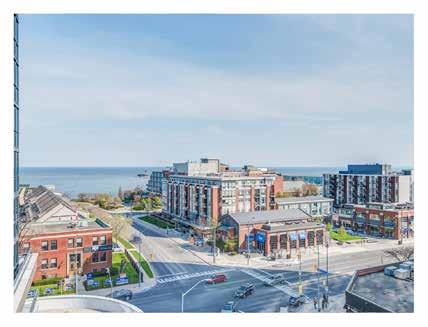REALTY GROUP THE TOPOWER MOVE YOU
NOV 2022

.com
tbaird

2 Power to Move You

NOVEMBER 2022 Issue FEATURES 6 Cabin fever - A river retreat goes from lackluster to instagrammable 8 Winterizing your home - Now is a good time to ensure you’re ready for winter 10 New increases to Ontario’s non-resident speculation tax 14 Don’t be house poor -- Having the best home on the block isn’t always good 16 A more balanced market - Muskoka’s housing correction spells good things 19 Deep dish apple-cranberry pie 20 Tropical splendor - A fresh approach that will transform your garden 24 Should we scrap daylight saving time? 6 myths about daylight saving time 30 Uncorked - Getting the most out of your wine-tasting experience PROPERTIES 12 48 North Forster Park Drive For Sale 22 1 Hurontario Street SOLD 28 4 Van Derburgh, New York For Sale - 1/8th Ownership 32 Bridge House at Brightwater Pre-construction For Sale 34 Bronte Lakeside Condos in Oakville Pre-construction For Sale 36 204 - 9653 Montelanico Loop, Florida For Sale 38 796 96th Avenue North, Florida Pre-construction For Sale Power to Move You 3
As 2022 is nearing an end we find ourselves acknowledging two very different celebrations. The first is Remembrance Day. A day where with the greatest respect we honour the sacrifices of those who have fought and lost their lives in the line of duty. What does Remembrance Day mean to you? We would love for you to share your story with us! To me, Remembrance Day is a day to celebrate the life of my Mother-in-Law Beulah Faubert. She passed away on Remembrance Day in 2014. Her brother Jack died in the war at an early age and every year Beulah and Bernard went back to the Legion and local school in Chatham where she grew up. It was her way to celebrate her brother and keep his mem ory alive for all of us. I know that her death on that very day was her way of being sure that we would never forget both of them.
Christmas on the other hand is a time of joy, celebration, and family gatherings. We know that many will celebrate and embrace the season with friends and family, while others will struggle through the holidays. Our team would like to help those who are struggling (mentally, physically, or financially), and have committed to donating a portion of our professional fees from our real estate sales to support CAMH and The Compass Food Bank. We have included a special digital segment inside this magazine to introduce the two charities we support. Our Mission to GO SERVE BIG keeps us dedicated each day to serve and support others.
We hope that if you, a friend, or a family member are considering selling, buying, or investing in real estate you will consider us as your trusted Real Estate Team and reach out to us to guide you through this process. The relationships that we have had the pleasure of developing and continue to enjoy are incredibly important to us. Thank you for giving us this opportunity and for referring us along to others, so that we can continue to help others and give back to our community!
Sincerely,
Theresa Baird Broker


KW Real Estate Associates Inc., Brokerage 103 Lakeshore Road East, Mississauga 647-298-0997 | tbaird@tbaird.com

4 Power to Move You
REALTY GROUP tbaird.com
SPREAD THE
GIFT OF KINDNESS


Power to Move You 5
CABIN FEVER
A RIVER RETREAT GOES FROM LACKLUSTER TO INSTAGRAMMABLE
In talks of the Canadian real estate market, multi-property home ownership remains a hot topic, as fingers point to investors as contributors to the country’s housing crisis. But speculation may not be as big of an issue as it is made out to be - not in Ontario at least - according to new research.
When Daniel Epperson and his wife, Brit - the architects and designers behind California-based Studio PLOW - first saw this 1974 A-frame cabin, it wasn’t exact ly earning an A. And yet they had hope. “We happened upon this modified A-frame right on Austin Creek that feeds into the Russian River, and kind of fell in love with it,” Epperson recalls of the Sonoma County, California location. “We saw the potential.” But it was decidedly down on its luck. “It was very much a river home—with all the charms of the architecture of the area, but hadn’t been touched since it was built. It was in good shape, but out of date.” Think faux-wood paneling, thick shag carpeting that “hadn’t been replaced in a really long time,” and a porous redwood structure that had soaked up the most unpleasant scents of a previous owner. What a difference two visionaries working in tandem make. “We started working together on the proj
ect and it was an effort to maximize impact on a tight, limited budget,” says Epperson. “We really had to flex that muscle of creative solutions for unique problems.” One of their biggest impact decisions was a no-brainer: pulling out the aforementioned carpet of horrors. “And then we found a sealant we could seal the wood with,” he says. “It was this penetrative oil that we could lock in the smells with and then paint over it.”
The coats of fresh paint provided an efficient, cost-effective fix for the existing dark feel, now trans formed into the successful short-term rental known as Caz Cabin. “The redwood itself made the space really dark, and being under the trees themselves, it’s kind of compounding,” he recalls. “We wanted to lighten up the space and bring the light that you get from the creek. So we made that decision to paint it mostly all white, and then it was more about stripping things back
Written by Kathryn O’Shea-evens / Photography by Avery Smith & Suzannna Scott Source: homesbydesign.com
6 Power to Move You
and trying to keep it minimal and quiet.” Occasional In stagrammable touches give the ’70s-era property a very “now” look, including the artful Flos light fixture in the kitchen. “Having some key moments that were really spe cial, whether it’s a light fixture or fireplace - the kind of hearth of the home - really popped.” The cookspace was an Ikea hack: “We bought Ikea [cabinet] bodies and had custom fronts and side panels made. We did all the installation work ourselves.” One other pièce de résis tance? The fireplace, including a show-stopping porce lain-tile wall they built behind the original wood-burning stove. “We wanted to maintain [the stove] because it’s kind of rad. It’s super cool.”
While the couple initially sought to use it as their primary weekend getaway, they toyed with it be coming a short-term rental - and it’s been a boon. “We try to provide a bit more than your standard Airbnb, where we create itineraries for guests depending on the weather and have cabin-specific cocktail recipes that we recommend,” he says. Locally sourced touches also help give guests a luxe, regional feel. “The ceram ics we have for guests are by a local artisan, which we mention in the guidebook we send out. It’s important to us that the things that made it special for us were there for guests too.”
Indeed, it’s a short-term rental version of the golden rule: treat others as you’d wish to be treated. “We want to ensure those that stay with us have that same magical experience that we had when we fell in love with the place.” One wonderful thing about the locale is that it’s both riveting and restorative in all seasons. “It wasn’t dependent upon the weather, which was kind of amazing,” says Epperson. “Whether it was raining or whether it was 80 degrees outside, there was all these amazing things that you could do, from reading a book by the fireplace to getting out in the creek. There’s even a little swimming hole about fifty yards up from us that you can wade up to. We want to make sure anyone that stays there knows all about these little secrets.”
SWEET SONOMA COUNTY
Here are three things to see in one of Califor nia’s most iconic getaways, all on the must-do lists of the Caz Cabin proprietors.
Armstrong Redwoods State Natural Reserve. Wander through a pristine grove of towering Sequoia trees . . . some of them up to 1,000 years old. (Go in the morning to catch them swaddled in moody fog, a frequent visitor in these temperate rainforests.)
Bodega Bay. Whale watchers flock here (or should we say swim here?) to spy migrating gray whales, who often pass through these waters January through May. Like the sequoia, they’re eye-poppingly large; an average sized gray whale can reach 90,000 pounds.
Williams Selyem Winery. A mainstay of oeno philes thanks to their perfect Pinot Noirs. Be come a member to attend a private tasting in the aptly named Tasting Salon, or just pick up a bottle to tote home (the 2020 Central Coast Pinot Noir is one of the rare great things to come from the infamous year).

Power to Move You 7
WINTERIZING YOUR HOME
WITH THE CHANGING OF THE SEASONS, IT CAN BE A GOOD TIME TO TAKE STOCK OF YOUR HOME AND ENSURE YOU ARE READY FOR THE COLDER WEATHER.
To help you feel more comfortable, save on bills and prevent future repair costs, there are some simple things you can do to prepare for the coming season.
Tending to minor problems yourself, or booking a professional now, will save you time and aggravation later when poor weather makes it harder to tackle home maintenance jobs.
Service Your Heat Source: Before Winter starts, be sure to have a professional check and clean your heat sources. You should have your chimney cleaned out if using wood heat or make sure to update your oil heater’s filters and service gas furnaces regularly.
Check Your Pipes: Checking pipe joints for leaks that could cause rot and damage will save you trou ble in the future. Repair any cracks you find, especially those around electrical outlets and alarm system lines. You can also consider foam pipe insulation, which is fairly easy to install and could help prevent energy loss and potential water damage from frozen pipes.
Mind the Gaps: Search exterior window frames,
doors and siding for cracks and gaps where water could get in. Doors and windows commonly have gaps that let cold in and heat out. Some will be easy to fill or fix yourself but could save you money and damage down the line!
Insulation is Key! On a snowy day go outside and look at your roof; you should see snow on the roof. If you can see your roof that means the attic is not insu lated well and heat is escaping and melting the snow. If this is the case, you will want to have it repaired and packed to ensure you are not losing excess heat during the winter months.
Create a Storm Kit: A storm kit is a handy source of essential items in the event of losing power. Consider what you and your family might need, such as a flashlight with new batteries, candles, matches, a portable radio, water and snacks. Keep your kit somewhere easy to access!
Part of a newsletter authored by George Douzenia, Mortgate Broker
Source: November 2022 Newsletter
8 Power to Move You

Power to Move You 9
On October 25, the Government of Ontario announced amendments to the Non-Resident Speculation Tax (NRST). Here’s what REALTORS® need to know about the changes to the NRST and how it might impact their transactions.
As of October 25, 2022, the NRST rate will be increased from 20% to 25% and continues to apply to all regions of the province. The NRST applies to the trans fer of “designated land”, which is considered land that contains at least one and no more than six single family residences.
Back in March, the government raised the NRST from 15% to 20%. The new increase to 25% makes this the highest provincial tax in Canada that exists to deter foreign speculation in the housing market.
How the NRST is Applied
The NRST will continue to apply to individuals who are not Canadian citizens or permanent residents of Canada or by foreign corporations or taxable trustees. Note: The NRST applies if any one of the trans ferees is a foreign entity or taxable trustee, regardless of their share of ownership. For example, if a transfer of residential property is made to four transferees, only one of which is a foreign entity, the NRST would apply to 100 per cent of the value of the property.
Certain individuals will continue to be exempt from the NRST, including foreign nationals in the On tario Immigrant Nominee Program, protected persons (refugees), spouses of Canadian citizens, or permanent residents of Canada.
Increasing the tax rate to 25% is an attempt by the Government of Ontario to further deter non-resident investors from speculating in the housing market in hopes that home ownership will become more attain able for Ontario residents.
If my client, who is subject to the NRST, pur chased a property before October 25, 2022, would they still pay the new 25% tax rate?
Transitional provisions as part of the increased tax include an exemption from the new rate (25%) if the agreement of purchase and sale on the property was entered into on or before October 24, 2022. Buyers that meet these criteria may still be eligible to pay either the 20% rate (if the agreement was entered into on or after March 30, 2022) or the 15% rate (if the agreement was entered into prior to March 30, 2022). Similarly,
Written by OREA Government Relations Source: Ontario Real Estate Associaton

10 Power to Move You
no NRST should be payable if the land is located out side of the Greater Golden Horseshoe (defined in the Act) and the agreement was entered into prior to March 30, 2022. The regulation deals with obvious attempts to avoid the tax by characterizing transactions which may originate after those dates as assignments of original agreements of purchase. It does this by specifically ap plying those same deadlines to assignments of older agreements of purchase and sale.
The tax applies to all transfers of residential property that contains at least one and not more than six single family residences. This includes detached homes, semi-detached, triplexes, duplexes, townhouses and condominium units. It does not matter whether a single family actually resides there nor whether the property is rented or occupied by the owner; it remains taxable so long as it was designed for occupancy as the residence of a family.
The NRST does not apply to other types of land such as land containing multi residential rental apart ment buildings with more than six units, agricultural land, commercial land or industrial land.
Is the NRST payable on top of the Land Transfer Tax?
While the NRST is imposed by the Land Trans fer Tax Act and administered through the same mecha nisms, the NRST, if applicable, is an additional tax that is
payable above and beyond the normal Land Transfer Tax by your client.
My clients are looking to purchase a home in Toronto. One is a Canadian citizen, the other is neither a Canadian citizen nor permanent resident nor a protect ed person. How is the NRST supposed to apply?
If your clients are not spouses as defined in the Land Transfer Tax Act on the date of the home purchase, the NRST should be payable on the full value of the home (one partner’s “portion” or contributions are not exempt, no matter if they are a Canadian citizen).
If your clients are spouses, they should be ex empt from the NRST if they are purchasing the house together and no other foreign entities are acquiring an interest in the house.
For more information, including how to pay the NRST or whether your clients might qualify to apply for a rebate, visit the Government of Ontario’s website: www.ontario.ca/document/land-transfer-tax/non-resi dent-speculation-tax.
As the provisions in the Act and the Regulation are complex and fact specific, appropriate legal advice should be sought, since this communication only pro vides an overview in the absence of specifics and does not constitute legal advice. Please email us at govern mentrelations@orea.com if you have questions or con cerns - we are here to help.
Power to Move You 11

FOR SALE 48 NORTH FORSTER PARK DRIVE OAKVILLE 12 Power to Move You
A rare opportunity calls to you on this large irregularly shaped lot filled with mature trees and perennial gardens.
Near Forster Park, great schools and a short drive to all that downtown Oakville has to offer. A charming bungalow with space to entertain and relax. This could be your new home, just give us a call to find out more.



Power to Move You 13
DON’T BE HOUSE POOR
HAVING THE BIGGEST AND BEST HOME ON THE BLOCK SOUNDS GREAT – BUT NOT IF IT IS AT THE EXPENSE OF YOUR LIFE AND MONTHLY FINANCES!
Be smart about your budget and avoid buying a home at the very top of your pre-approval value, which might lead to cash flow issues and being “house poor” down the line.
Home Expenses When it comes to your home, it is more than just your purchase price and mortgage cost. While you might be able to afford to buy a $800,000 home, can you also afford the maintenance, property taxes, utilities and more?
When it comes to your home expenses and overall monthly budget, the goal is that the costs to maintain your home do not exceed 35% of your total monthly income.
Monthly Budget To help you keep track of your finances, consider breaking up your monthly budget into the following categories:
• Housing - mortgage payments, property taxes, utilities, etc.
Transit - car payments or transit passes, gas, mainte nance, etc.
• Debt - payments to credit cards, lines of credit, etc.
• Savings - your long-term savings for retirement, etc.
• Life - food, vacations, fun, medical, childcare, etc. From there, you would want to look at how much you spend on each category. The below is a good rule of thumb:
• Housing - 35% of your monthly income
• Transit - 15% of your monthly income.
• Debt - 15% of your monthly income
• Savings - 10% of your monthly income Life - 25% of your monthly income
By spending too much on housing, you are forced to sacrifice in other areas of spending such as your life or savings, but it is better to be life RICH than house POOR
If you’re not sure what you should budget for your new home, or have questions about making your home costs more affordable (such as changing your mortgage payments), please don’t hesitate to reach out to me today.
Part of a newsletter authored by George Douzenia, Mortgate Broker
Source: November 2022 Newsletter
14 Power to Move You

Power to Move You 15
A MORE BALANCED MARKET
MUSKOKA’S HOUSING CORRECTION SPELLS GOOD THINGS FOR PROSPECTIVE BUYERS
Like Canadian real estate on the whole, Muskoka’s market has experienced a cool down this year as the world has inched back to its pre-pandemic ways. Demand in cottage country has levelled out, but according to a local realtor immersed in its luxury market, this spells good things for prospective buyers.
“Prices are off a good 20% from the height in March or April, and with the chance of further increased rates and a recession, there could be another 5% or 10%. So, you’re looking at a 25% to 30% average price reduc tion from the height,” says Steve Haid, Managing Partner of PSR Brokerage Muskoka. “Over this fall into next spring is a great time for people to buy real estate in Muskoka.”
Haid began noticing signs of a housing correc tion in March, and softening conditions ever since. Ac cording to the most recent figures from the Lakelands Association of REALTORS, sales of waterfront properties were off 44.9% from the year prior in September, while non-waterfront sales were off 39%. Sales of both property types were below the five-year average, as well as the 10year average for September.
As such, total dollar values also saw a year-overyear decline. More specifically, waterfront sales totalled
$156.9M, down 45.9%, while non-waterfront sales to talled $259.5M, down 41.3%.
But Haid warns this is “just a transitional period.” Muskoka has chronically low housing supply, particularly in the lakefront segment. “And that’s just because prop erties are passed down through generations and a lot of families don’t sell their properties. We’re looking at one of the lowest times in the history of inventory.” This means it won’t take much for demand to intensify once again. With that said, the high interest rate environment has moderated Muskoka’s market for the time being. Haid says that, historically, the region tends to see an uptick in selling activity in the fall - and as such, properties are typi cally priced higher - but that isn’t the case this fall.
“Even though inventory is low, the buying men tality is not there. Buyers aren’t pulling the trigger, so properties are sitting on the market longer,” he says. “It’s
Written by Zakiya Kassan - Photography by Steve Haid with PSR Brokerage Source: Storeys.com
16 Power to Move You

Power to Move You 17
allowing buyers a better chance to negotiate and put in conditions; financing conditions, home Inspection condi tions. It’s getting to a more balanced market like it used to be before the pandemic.”
While Muskoka’s market is more buyer-friendly than it has been in years, the high interest rate environ ment is certainly impacting lending.
Donna Murphy, a local mortgage agent, says that since the latest rate hike, she’s had an uptick in inquiries from prospective buyers looking to understand their lend ing options.
“The biggest question is, ‘do we go variable or fixed?’” she says. “If you are not concerned with fluctuat ing mortgage payments or interest rates, historically, the variable has done well, but it is a personal preference. Some people are starting to choose the fixed option now as opposed to riding out the variable.”
In addition to discussing rate options with a mort gage agent, Murphy urges anyone interested in purchas
ing in Muskoka to ask about payback penalties - should a buyer purchase a luxury cottage and choose to sell in a few year’s time - and options for leveraging an existing mortgage against a new one, if someone is looking to relocate.
With winter around the corner, Haid recommends purchasing now or come spring. Although he can only speculate as to when it will be, he expects demand to come back in a big way.
“As soon as interest rates stabilize, we’re probably gonna see a very robust real estate market going forward, and we will see prices increase a lot again,” he says. For gun-shy buyers, he recommends connecting with a local realtor to, at the very least, understand the buying oppor tunities out there.
“It’s a prime real estate area. So typically, if you buy in a prime cottage country area like Muskoka, real estate tends to hold its value or appreciated value just de pending on how the real estate market is going.”

18 Power to Move You
DEEP DISH APPLE-CRANBERRY PIE
In the 1600s, pilgrims brought their favorite pie recipes to America and adapt ed them to work with ingredients that were available. Cranberries, fruits, and nuts went into pies like this one, with a sugary mixture spread over the top.
INGREDIENTS: PASTRY FOR SINGLE CRUST PIE
1 12 ounce pkg. fresh or frozen 1 ½ cup chopped, peeled cooking cranberries or frozen unsweetened apples pitted tart red cherries
1 ½ cup chopped, peeled ½ cup chopped walnuts or cooking apples ½ cup butter, melted pecans (2 medium)
½ cup chopped walnuts or pecans ⅓ cup all-purpose flour
2 eggs Vanilla ice cream
½ cup butter, melted 1 ½ cup sugar
INGREDIENTS:
PASTRY FOR SINGLE CRUST PIE
1 ½ cup all-purpose flour
¼ cup shortening or lard
¼ cup butter, cut up, or shortening or lard
DIRECTIONS
½ teaspoon salt
¼ cup ice water
Preheat oven to 350°F. Prepare Pastry for Single-Crust Pie. On a lightly floured surface use your hands to slightly flatten pastry ball. Roll pastry into a 13-inch circle. Line a 9-inch deep-dish pie plate with pastry circle. Trim and flute edge.
In a medium bowl toss together cranberries and apples; add to pastry shell. Sprinkle 3/4 cup of the sugar and the nuts over top.

In a medium bowl whisk together next three ingredients (through butter) and remaining 3/4 cup sugar until combined. Spoon over fruit mixture; spread evenly.
Place pie on a baking sheet . Bake 1 hour or until golden and bubbly. Cover loosely with foil and bake 15 to 25 minutes more or until center is nearly set. Cool on a wire rack at least 30 minutes before cutting. Serve warm or at room temperature with ice cream.
DIRECTIONS FOR PASTRY FOR SINGLE-CRUST PIE
In a medium bowl stir together flour and salt. Using a pastry blender, cut in shortening and butter until pea-size. Sprinkle 1 Tbsp. of the ice water over part of the flour mixture; toss gently with a fork. Push moistened dough to side of bowl. Repeat moistening flour mixture, gradually adding ice water (1/4 to 1/3 cup total) until mixture begins to come together. Gather pastry into a ball, kneading gently just until it holds together.
Recipe and photo on bhg.com
Power to Move You 19
TROPICAL SPLENDOR
Tired of the tried-and-true, traditional garden designs? Take a fresh approach by transforming your garden into a tropical oasis. The look doesn’t have to be limited to climates like Hawaii, Florida, and coastal Southern California. By following the tips below, you can create your own tropical paradise wherever you live.
Creating the Tropical Look. Lush foliage is key to the tropical look. Layer lots of plants, mixing trees, shrubs, flowers, and ground covers. Different textures add visual interest as do varied shades of green. Largeleafed plants such as hardy bananas, elephant ears, and Japanese aralia are particularly effective. Your mantra should be density.
Choose big, bold, hot-colored flowers in bril liant reds, hot pinks, clear yellows, and dynamic orang es. The more exotic the flower, the better. Look beyond the everyday petunias, marigolds, and pansies to flow ers such as canna lilies, ginger, and passion flowers. Also include plants with vibrantly hued leaves such as Cannas (‘Yellow King Humbert’, ‘Durban’, and ‘Pretoria’ all have gorgeous, multicolored pinstriped leaves), cala dium, and croton.
The third important feature is water. You can opt for a simple wall or freestanding fountain or go big with
a pond that can host tropicals such as papyrus, elephant ears, or water cannas.
If you have a large shade tree, make that part of your garden. Place a bench or table and chairs under the tree canopy to enjoy the shady outlook into the gar den. A lath-covered arbor or patio offer good, shady options too.
Finish the look by adding a few personal decora tive touches. An interesting sculpture or locally quarried statement rock are possibilities. String lights, tiki torch es, or a fire pit provide a festive feeling for warm, summer-night parties. A hammock or tree swing provide is land-style seating, while weather-resistant wicker gives a coastal vibe. Outdoor cushions in exotic prints finish the look of tropical splendor in your private garden space. Overwintering a Tropical Garden. There are several strategies to keep tropical and subtropical plants alive during the winter. In USDA climate zones as cold
Written by Catriona Tudor Erler - Photography by Getty Images Plus Source: HomesbyDesign.com
20 Power to Move You
as 6, semi hardy plants can remain in situ in the garden if you apply a thick layer of mulch around the roots and wrap the plant to shield it from the cold. Others, such as citrus jasmine, tropical hibiscus, and other woody plants benefit from overwintering indoors. Plants with rhizomes, fleshy tubers, corms, or crowns will survive overwintering indoors as bareroot plants. Lastly, fleshy, soft-stemmed tender plants root easily and take up less space for overwintering indoors.
Mulching and Wrapping. Before the cold weather sets in, insulate the roots with a three- to fiveinch layer of mulch. The colder your climate, the thicker your mulch should be. Wrap the plant in a frost blanket, which is a cover made of lightweight, polypropylene fabric, or other material (traditionally old bedsheets, blankets, or burlap). Among the good candidates for this approach are hardy bananas.
Overwintering Indoors. Sun-loving tropical plants will require a sunny room where the daytime temperatures stay between 60 and 70 degrees F and nighttime temperatures don’t drop below 40 degrees F. Small plants will happily spend the winter months under a grow light providing twelve hours of light a day. Wa tering frequency will depend on the plant; be aware that overwatering is the primary cause of houseplant death.
Root Cuttings. Herbaceous, soft-stemmed plants such as coleus, begonias, and geraniums, are good candidates for rooting cuttings. Choose young, succulent stems, cut them four- to six-inches long, re move the lower leaves, and keep them in water on a windowsill. Once a good set of roots has developed, plant the cuttings in pots. Keep them in a sunny lo cation or under grow lights until all danger of frost has passed. Acclimate them to the outdoors by putting them outside for a few hours, extending the time each day for about a week.
Lifting and Storing. Tropical plants that grow from bulbs or tubers, such as elephant ears, caladi um, and canna lily are excellent candidates for lifting and storing. Unearth the plant, cut back the foliage, and wash the loose soil off the bulbs. To prevent rot, air dry them in a well-ventilated spot. When dry, wrap individual bulbs in newspaper with a small amount of peat moss or vermiculate to absorb moisture. Store the separately wrapped bulbs in a cardboard box or paper bag in a cool, dry location with temperatures above 40 degrees F.
By choosing the right plants and giving them the right care, you can transform your garden into a tropical paradise, today.

Power to Move You 21
SOLD 1 HURONTARIO STREET MISSISSAUGA

22 Power to Move You
Classic living at its finest with modern amenities, great location and access to great cultural events that take place every year in Port Credit Village. Congratulations to the new owners who now get to discover new dining and entertainment experiences and stroll along the waterfront trails.


If you’re a North Shore owner looking to sell, we have the perfect buyer for your condo. We can sell your condo fast, for top dollar, with the least amount of hassle.

Power to Move You 23
Should We Scrap Daylight Saving Time?
We asked Blake Shaffer, environmental and energy economist, and currently a Fulbright Scholar at Stanford University, to weigh in on the pros and cons of daylight saving time.
There’s some controversy around who invented day light saving time - some say it was Benjamin Franklin. Care to weigh in?
I don’t think you could say Franklin invented it, but he was one of the first people to point out the folly of sleeping away the daylight hours, which he did in a satirical essay published in 1784. We do know that Port Arthur, Ontario (now Thunder Bay) was the first place in the world to implement DST, in 1908, so that’s kind of a claim to fame for our country.
Why there of all places?
Societies further from the equator tended to adopt the time shift, since those closer don’t get the big swings in daylight hours. As to why Port Arthur specifically did it first, I’m not sure. But DST then became widely adopted during the First World War, when it was
seen as a way to save energy by burning less coal. In 2005, George W. Bush expanded it so that we spring forward in March instead of April and turn the clocks back in November instead of October. That was part of the Energy Policy Act of 2005, so it was still tied to the idea that DST saves energy.
Does it?
Definitely not in the same way it once did. Light ing technology has evolved so much even over the last 20 years: LED lighting uses up to 80 per cent less elec tricity than incandescent bulbs did. That said, last year my colleague Nic Rivers at the University of Ottawa pub lished research that showed a 1.5 per cent reduction in energy in Ontario during DST. That’s a big deal, so I replicated the experiment in Alberta, where I liveand got the exact same result. But in any case, some
Written by Courtney Shea - Photography by Shutterstock and Adobe Stock Source: readersdigest.ca
24 Power to Move You

Power to Move You 25
Albertans would rather have sun in the morning. We’re a more agrarian society, so we tend to be early risers compared to Ontarians, who really like their sleep. Ob viously, that’s a massive generalization… I don’t want to offend anyone!
Well, one’s individual lifestyle is a big factor. If you’re a golfer, you might be a huge fan of DST because it means you can be on the course until after 10 p.m. If you’re a parent trying to get your children to school, you might prefer that hour of light in the morning. As the father of four, I can tell you that even just those few days of adjustment can be extremely trying. In our house, the kids set the schedule, regardless of what the clocks say.
I’ve heard that DST causes detrimental effects to our health. Should that be considered?
When the clocks go forward, there is a demon strable spike in heart attacks - and traffic accidents - based on losing an hour of sleep. But also, brighter nights are associated with more physical activity in the evening
and a higher average caloric burn. Again, there are pros and cons to both.
There was a study seven years ago that claimed DST led to a spike in “cyberloafing” - that is, wasting time on the Internet. Have you heard of this?
Yes, but I’m not sure that’s caused by DST. I guess if we’re going to attribute being tired to the time change, we can blame DST for a lot of things. But not being late. Smart clocks have mostly taken care of that. They have, but I still use manual clocks in one of our cars and on my stove. Also, the other day, Nic Rivers was supposed to call me at 9 a.m., and by 9:10, I was looking at the time and wondering why he was late. I had forgotten that he was in France, where they go back and forth in October and at the end of March.
If two DST experts can’t get a handle on it, what hope is there for the rest of us? That’s fair. We said the same thing.
What Everyone Gets Wrong About Daylight Saving Time
Written by Robert Liwanag - Photography by Adobe Stock Source: readersdigest.ca
Myth: It’s Called “Daylight Savings Time”
The Real Story: In North America and Australia, the convention of setting our clocks ahead one hour in the spring and behind one hour in the fall is properly known as “Daylight Saving Time.” For whatever reason, we’ve developed a habit of referring to it conversation ally as “Savings Time,” plural. Britons refer to DST as “Summer Time,” while in Italy, the practice is called “Ora Legale.”
Myth: Benjamin Franklin Invented Daylight Saving Time
The Real Story: Thanks to An Economical Project, a satirical essay Franklin wrote in 1784 urging Parisians to adopt an earlier sleeping schedule, the U.S. Founding Father is often credited with “inventing” daylight saving time. Actually, that honour belongs to William Willett, a
British builder. While on an early morning horseback ride on the outskirts of London in 1905, Willett theo rized that if the United Kingdom moved its clocks for ward by 80 minutes between April and October, Brit ons would be able to enjoy more sunlight. Willett spent much of his own personal fortune trying to persuade British Parliament to embrace the idea, but he died in 1915 without seeing his dream come to fruition.
Myth: Germans Were the First to Embrace Daylight Saving Time
The Real Story: Germany adopted daylight sav ing time (DST) in 1916 to conserve energy during World War I. While Germany was indeed the first country to observe the practice, certain regions of Canada were already following DST as early as 1908. On July 1 of that year, residents of Port Arthur in Ontario - what is now
26 Power to Move You
Thunder Bay - were the first in the world to turn their clocks forward by one hour. In Saskatchewan, Regina implemented DST in 1914 (where it was enormously popular with local townsfolk), and Winnipeg followed suit in 1916. The German Empire may have popular ized daylight saving time, but Canadians beat them to the punch.
Myth: Daylight Saving Time is Observed Everywhere
The Real Story: Changing the clocks may be standard practice across much of Canada, but not all countries observe daylight saving time. Countries along or below the equator, for instance, don’t imple ment time shifts since daylight hours rarely change from season to season. Much of Asia and Africa opt out of DST as well, as do Iceland and parts of Aus tralia. Closer to home, Arizona, Hawaii, and regions of Quebec and Saskatchewan choose not to observe DST either. There’s one exception, however: even though Antarctica has no daylight in the winter and 24-hour daylight in the summer, research crews living in the area observe DST to communicate with their home bases.
Myth: Daylight Saving Time Makes Us Healthier
The Real Story: More sunlight may mean more
vitamin D, but numerous studies have also linked day light saving time to a rise in road accidents and health problems. A 2008 Swedish study in the New England Journal of Medicine - based on information collected over a 20-year period - found a higher incidence of heart attacks in the first three weekdays after clocks move forward and fall back. Meanwhile, according to Manitoba Public Insurance, there was a 20 per cent increase in crashes on Manitoba roads when clocks moved forward an hour in the spring of 2014. Changes in circadian rhythm, too, can trigger cluster headaches and lead to days or weeks of discomfort.
Myth: Daylight Saving Time Helps Farmers
The Real Story: When the United States passed the Uniform Time Act in 1966, it gave rise to the myth that the extra daylight would give farmers more time to harvest their produce in the morning. In reality, it has the opposite effect, and farmers tend to have been the loudest critics of DST over the past several decades. One of the main reasons DST picked up steam in North America after the World Wars was because department stores lobbied for the practice. Why? Well, more day light means more business: commuters leaving work while the sun is still shining are more inclined to shop before they make their way home.

Power to Move You 27







FOR SALE | 1/8th ownership 4 VAN DERBURGH STONE RIDGE, NEW YORK, USA 28 Power to Move You
This simple yet sophisticated modern farmhouse nestled in the beautiful Hudson Valley is just 90 minutes north of New York City.

Located on a 2.43 acre lot, this gorgeous retreat home offers privacy, quiet and seasonal mountain views.
One of only 8 homes being sustainably built in a new community situated in a wooded 44 acre parcel of land. Don’t wait until it’s too late, call Theresa for more details.

Power to Move You 29
UNCORKED
The last whispers of autumn signal the end of the harvest season—and one of the best times to go wine tasting. Late fall brings fewer visitors, golden vistas, and specialty tastings. Never been much of a wine connoisseur? Here are a few basics to help you navigate your trip to sip.

Like any industry, oenology (the study of wine and winemaking) has its own vernacular. A sommelier is the trained professional often pouring your wine. As a wine steward, they are your guide to all things vino. Need a tasting recommendation? Curious about the science behind the wine you’re drinking? They’re the experts. A flight is a series of small pours of wine. Sometimes accompanied by tasting notes or food pairings, these two-to three-ounce pours are grouped for a pur
pose, and usually meant to be sipped in a particular order. Sweet vs. dry wines—what’s the difference? This distinction refers less to the actual taste and more to the wine’s makeup. If a wine has residual sugar after fermentation of less than 1 percent, it is considered a dry wine. Tannins are compounds found most frequently in red wines. They have a bitter quality and are more notice able in younger wines. The level of acidity in wine con tributes to its tartness. Wines with higher acidity might
Written by Victoria Hittner - Photography by Alessandro Biascioli Source: HomesbyDesign.com
30 Power to Move You
GETTING THE MOST OUT OF YOUR WINE-TASTING EXPERIENCE
add a little tingle to your tongue as you’re drinking. ABV is simply the amount of alcohol by volume. The average wine will contain about 11 to 13 percent ABV. A wine’s body can be defined as the way it feels in your mouth after taking a sip. Wines are generally catego rized as light-bodied, medium-bodied, or full-bodied. A popular analogy is the weight difference you feel when drinking skim milk, whole milk, or cream.
Sipping Like a Pro. Walk into a tasting room and you’ll likely see someone engaging in the “5 S’s” of wine tasting: see, swirl, sniff, sip, and savor. It may look pretentious, but this five-step process is the gold standard for getting the most out of your wine.
See: The intensity of a wine’s color and opacity can tell you a great deal about its age and style. Here’s a hint: red wines fade in color as they age while white wines intensify. Swirl: Hold your glass by the stem and move your wrist in a circular fashion. This aerates the wine, encouraging the appearance of fragrant com
pounds. Sniff: Once you’ve swirled, place your nose above or into the glass to get a full smell of the wine’s aroma. Want to get better at identifying scents? Take a sniff and Google a wine aroma wheel. Sip: See if you can parse out primary characteristics (fruity or flo ral flavors) versus secondary characteristics (fermenta tion-related flavors like oak, clove, and vanilla). Savor: Now the fun part! Take a moment to enjoy how the wine finishes. How long does the taste linger? Is the after taste balanced? Or perhaps most importantly—would you like another sip?
Determining Your Palate. Don’t know which wines or flight to choose? If you’re new to wine, start with a sweeter white and work your way up to a drier red. Ask your sommelier for suggestions but be ready to share what flavors, foods, and beverages you enjoy. Just re member: Everyone’s palate is different and there is no “right” or “wrong” wine to enjoy. That’s what makes every tasting experience an adventure!

Power to Move You 31

32 Power to Move You PRE-CONSTRUCTION FOR SALE BRIDGE HOUSE AT BRIGHTWATER MISSISSAUGA
This master-planned community will ul timately consist of over 2,500 condos, 400 townhomes and over 300,000 sq ft of commercial and retail space. Now is the perfect time to get in on this great opportunity. Reserve your new home by contacting the Realty Group today.




Power to Move You 33
Oakville’s newest luxury waterfront residence is now available for you to purchase. Well-appointed suites, hotel-inspired amenities and much more all in the heart of Oakville’s Bronte Village. Don’t delay, you can choose your perfect suite now by calling the Realty Group today.




34 Power to Move You

Power to Move You 35 PRE-CONSTRUCTION FOR SALE BRONTE LAKESIDE CONDOS IN BRONTE VILLAGE OAKVILLE

FOR SALE 204 - 9653 MONTELANICO LOOP NAPLES, FLORIDA 36 Power to Move You
Live the good life in sunny Naples, Florida. A beautifully maintained home with everything you could want to have.



This immaculate property has been impeccably maintained and is a great space for entertaining. One look will convince you that this could be your next home.
Reach out to Theresa to see this stunning property.
Power to Move You 37

FOR SALE 796 96TH AVENUE NORTH NAPLES, FLORIDA 38 Power to Move You
Walk to the beach in warm and wonderful Florida. This bright and open home is perfect for family and friends with its plentiful outdoor space.



Only blocks from the Pelican Bay community park with a playground for the kids, tennis courts and walking trails.
This bright and open home is ideal for entertaining. Theresa can help make it happen.
Power to Move You 39

40 Power to Move You OCTOBER 2022 AVERAGE SELLING PRICE 5.7% less than Oct. ‘21 ($1,155,624) $ 1,089,428 SALES-TO-NEW-LISTINGS RATIO Oct. 2022: (4,961 ÷ 10,390) x 100 = Oct. 2021: (9,743 ÷ 11,749) x 100 = 48 % %83 SOLD NEW LISTINGS Detached $1,372,438 Semi $1,079,393 Townhouse $919,903 Condo $716,515 MARKET STATS AT A GLANCE HOME SALES 4,961 49.1% less than Oct. ‘21 (9,743)+Detached 2,300 Semi 446 Townhouse 822 Condo 1,338 NEW LISTINGS 11.6% less than Oct. ‘21 (11,749) 10,390 0 2K 4K 6K 8K 10K 12K October 2022 October 2021 ++-
Why Is the Realty Group One

Marketplace?
Well, we are still busy packing. How is it this is such an endless job! And it’s been crazy over the last two days. So sorry I haven’t reached out sooner - but a HUGE THANK YOU! Our dream house is beyond our dream house. I can’t get over how great the place makes us feel - I am instantly at home. And it only proves how important and impactful your environment is. Yesterday when we were there we saw a coyote in the background. Then we saw a rabbit - thank goodness it was in that order. I’ll be putting my desk together today and can’t wait to have that view for work. So thank you again, from the bottom of our hearts. We were a little nervous when we weren’t finding anything that made us go wow - and then questioned, yikes are we doing the right thing. Oh my goodness - did we ever do the right thing!
- Irene and Matt
Thank you "The TB Realty Group" for totally taking over and assisting in the preparation of our condo at "The Regatta" to go on the open market. With us living out of the country, we were so pleased that you took control of having our home painted, coordinated and chose all new lighting, totally staging our place and then selling it for us. We couldn't have selected a better team to work with and we were thrilled with the results you got for us. We will happily refer you to all our friends.
Theresa Baird is truly an outstanding, dynamic person. We have bought and sold 4 properties with Theresa and found her extremely professional and passionate about her clients and their property. If you're buying or selling, Theresa and her team are the people to get the job done for you.
- Meri
 - Christine and David
- Christine and David
Power to Move You 41
of the Best in its’




















































 - Christine and David
- Christine and David














